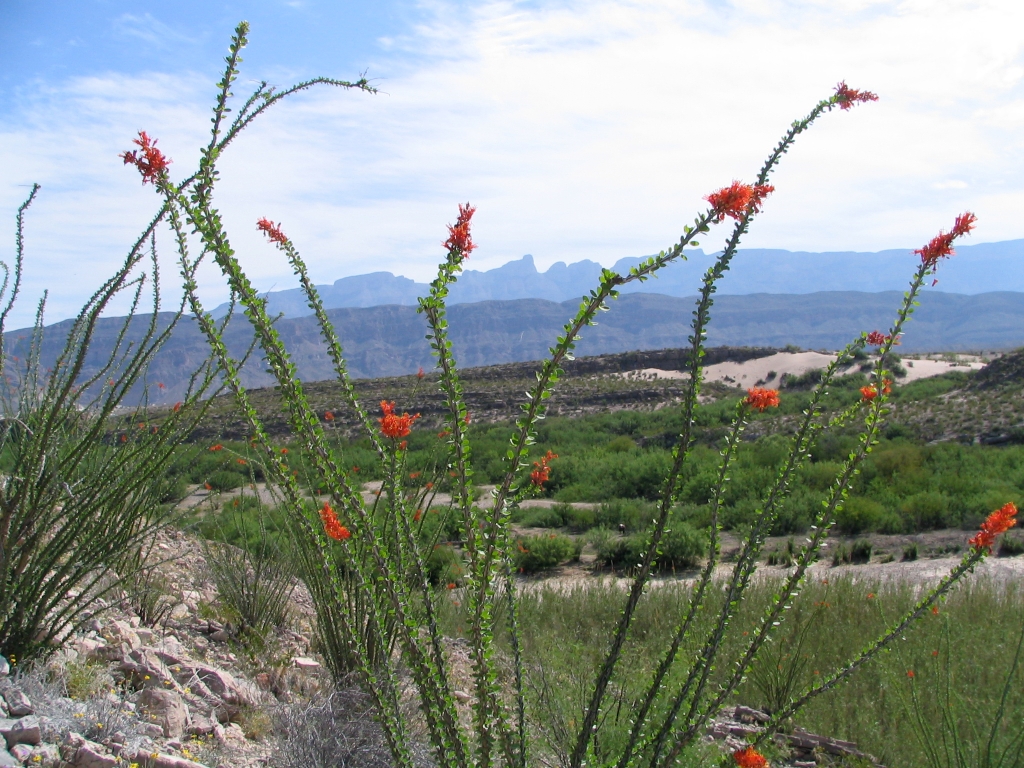
One of the most bizarre-looking plants found along this trail is the ocotillo. At first glance, ocotillo (pronounced “Oh-co-TEE-yo”) looks like a tall, spindly shrub that died - a cluster of drab, gray stalks covered in sharp half inch spines, and no obvious signs of life like leaves along the branches. This bare bones appearance is actually part of ocotillo’s desert survival strategy. Plants lose most of their water through their leaves during photosynthesis. Ocotillo and several other desert plants have adapted to desert life by moving the photosynthesis into their stems. This strategy of photosynthesis is not as efficient or as productive as in typical plants, but the plants do save a lot of water and that is the principal issue for a desert dweller. Leaves are either not produced, or only produced during wet times of the year when the water losses are affordable to the plant.
The real surprise though is in the spring when seemingly “dead stalks” of ocotillo burst into bloom. Slender clusters of bright red orange, tubular flowers form at the ends of the stalks, and in areas with abundant ocotillo plants it can look like a red haze is hanging just above the plants from a distance! Ocotillo are often mistaken for cactus, but in fact they are a member of a small, unrelated family of primarily South American plants, of which it is the northernmost representative.
The real surprise though is in the spring when seemingly “dead stalks” of ocotillo burst into bloom. Slender clusters of bright red orange, tubular flowers form at the ends of the stalks, and in areas with abundant ocotillo plants it can look like a red haze is hanging just above the plants from a distance! Ocotillo are often mistaken for cactus, but in fact they are a member of a small, unrelated family of primarily South American plants, of which it is the northernmost representative.
Is there something we missed for this itinerary?
Itineraries across USA

Acadia

Arches National Park

Badlands

Big Bend

Biscayne

Black Canyon Of The Gunnison

Bryce Canyon

Canyonlands

Capitol Reef

Carlsbad Caverns

Channel Islands

Congaree

Crater Lake

Cuyahoga Valley

Death Valley

Dry Tortugas

Everglades

Gateway Arch

Glacier

Grand Canyon

Grand Teton

Great Basin

Great Smoky Mountains

Guadalupe Mountains

Haleakalā

Hawaiʻi Volcanoes

Hot Springs

Indiana Dunes

Isle Royale

Joshua Tree

Kenai Fjords

Kobuk Valley

Lassen Volcanic

Mammoth Cave

Mesa Verde

Mount Rainier

North Cascades

Olympic

Petrified Forest

Pinnacles

Rocky Mountain

Saguaro

Shenandoah

Theodore Roosevelt

Virgin Islands

Voyageurs

White Sands

Wind Cave

Yellowstone

Yosemite

Zion